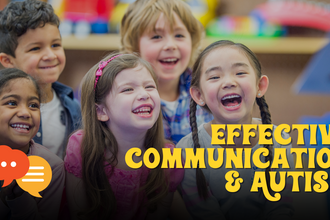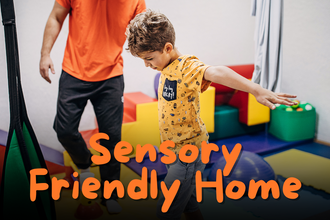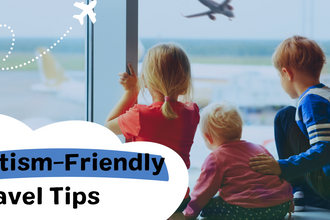
Traveling with a child who has autism can be both exciting and challenging. However, with careful planning and preparation, you can create a positive travel experience for your entire family.
This blog will share essential tips on how to plan and execute travel plans with an autistic child, including selecting destinations, choosing activities, and managing potential challenges.
Understanding Autism and Travel Challenges
Autism Spectrum Disorder (ASD) affects each person differently, but there are common challenges that many children with autism face during travel. Changes in routine, unfamiliar environments, and sensory overload can cause anxiety and discomfort. Understanding these challenges can help you prepare better for your trip.
- Routine: Many autistic children thrive on routine and predictability. Travel often involves changes in routine, which can be difficult for them.
- Sensory Overload: New places can have unfamiliar sounds, sights, smells, and textures. This sensory input can be overwhelming for some children with autism.
- Anxiety: The uncertainty and new experiences involved in travel can increase anxiety levels.
Pre-Travel Preparation
Preparation is key when traveling with an autistic child. Here are some steps to take before you leave:
Creating a Detailed Itinerary: Having a detailed plan can provide a sense of security for both you and your child. Include travel times, activities, meal breaks, and rest periods in your itinerary. Break the day into manageable segments, and make sure to account for downtime to prevent overstimulation.
Use a visual schedule if it helps your child understand what to expect. This visual aid can be a series of pictures or symbols representing different parts of the day, helping your child feel more in control and less anxious about the unknown.
Packing Essentials: Pack items that provide comfort and familiarity to your child. This might include favourite toys, blankets, noise-cancelling headphones, and snacks. These items can help soothe your child in unfamiliar settings.
Don't forget any medication or medical supplies your child may need. It’s a good idea to carry extra supplies in case of delays or emergencies. Also, pack a small first aid kit according to your child's specific health needs.
Communicating About the Trip: Talk to your child about the upcoming trip well in advance. Use visual aids, such as pictures and social stories, to help them understand what to expect.
These tools can illustrate each step of the journey, from packing and traveling to arriving at your destination. Practice any new experiences, like going through airport security, at home to make these situations more predictable and less intimidating.

Choosing the Right Destination
Autism-Friendly Destinations: Some places are known for being particularly accommodating to individuals with autism. Look for destinations that offer sensory-friendly attractions, quiet spaces, and staff trained to assist families with special needs. Here’s a list of autism friendly destinations.Factors to Consider: When choosing a destination, think about the availability of accommodations that can meet your child’s needs. Look for hotels that offer quiet rooms, have a pool, or are close to the attractions you plan to visit.
Recommended Places
- Smithsonian Museums, Washington, D.C.: The Smithsonian Institution offers a variety of museums, including the National Air and Space Museum and the National Museum of Natural History.
- Exploratorium, San Francisco, California: Known for its interactive exhibits and sensory-friendly environment.
- Amusement Parks:
- Sesame Place, Pennsylvania: A Sesame Street-themed park with sensory-friendly experiences and quiet spaces.
- Dollywood, Tennessee: Offers accommodations for sensory needs and a calming atmosphere.
- Nature Spots:
-
Great Smoky Mountains National Park, Tennessee/North Carolina: Explore the beauty of the mountains, waterfalls, and wildlife.
-
Acadia National Park, Maine: Enjoy scenic drives, hiking trails, and ocean views.
Transportation Tips
Getting to your destination can be one of the most challenging parts of the trip. Here are some tips to make the journey smoother:
Choosing the Right Mode of Transportation: Decide whether driving, flying, or taking a train is the best option for your family. Each mode of transportation has its own advantages and challenges.- Driving: Offers flexibility and control over the environment, but may involve long hours in the car.
- Flying: Faster for long distances but can be overwhelming due to crowds and security checks.
- Train: Offers a balance of speed and space to move around, but may still have crowds and noise.
Preparing for Security Checks and Queues: Airports and train stations can be overwhelming. Contact the airport or train station in advance to inquire about accommodations for children with autism. Many offer programs to help families navigate security checks more easily.
Managing Sensory Issues: Bring items to help reduce sensory overload, such as noise-cancelling headphones, sunglasses, or a favourite blanket. These can block out loud noises, reduce bright light, and provide comfort.
Plan for regular breaks in quiet spots to allow your child to decompress and relax. Creating a sensory toolkit with fidget toys or calming apps can also be beneficial during the trip.

Accommodation Tips
Where you stay can greatly impact your travel experience. Follow these tips to choose the right accommodation:
Selecting Autism-Friendly Accommodations: When planning your trip, search for hotels or vacation rentals that specifically advertise themselves as autism-friendly. These accommodations are more likely to have staff trained to understand and address the unique needs of children with autism.They may offer sensory-friendly rooms, provide information about quiet times, and have facilities designed to reduce sensory overload, ensuring a more comfortable stay for your family.
Requesting Special Accommodations: When making your reservation, clearly communicate any special requirements your child might have. For instance, request a quiet room away from elevators and high-traffic areas to minimize noise.
Ask for extra bedding to accommodate your child's preferences or a mini-fridge if your child has special dietary needs. Many hotels are willing to make these adjustments to ensure your child’s comfort.
Creating a Familiar Environment: To help your child feel more at home, bring along items from home that provide comfort and familiarity. Pack their favorite bedding, stuffed animals, or familiar toys.
Upon arrival, set up a small, cosy space in the hotel room with these items. This familiar setup can create a safe and soothing environment, helping your child adjust more easily to the new surroundings and reducing anxiety.
Activities and Entertainment
Keeping your child entertained and engaged during the trip is important. Here are some ideas:
Planning Suitable Activities: Choose activities that your child enjoys and that won’t be too overwhelming. Research in advance to find attractions with sensory-friendly options, such as quiet hours at museums or special accommodations at theme parks.- Outdoor Activities: Beaches, parks, and nature trails can provide a relaxing environment with plenty of space.
- Museums and Zoos: Many museums and zoos offer sensory-friendly hours or quiet areas.
- Amusement Parks: Some amusement parks offer sensory-friendly maps and quiet zones.
Managing Sensory Overload: Have a plan in place for when your child becomes overwhelmed. This might include finding a quiet space to relax, using calming techniques, or taking a break from the activity.

Communication Strategies
Effective communication can make a big difference during your trip. Here are some tips:
Informing Service Providers: Let airlines, hotels, and other service providers know about your child’s needs in advance. Many places are willing to make accommodations if they know ahead of time.Using Visual Aids: Visual schedules, social stories, and communication apps can help your child understand and cope with the travel experience. These tools can be especially useful in unfamiliar environments.
Dealing with Delays: Travel plans don’t always go as expected. Prepare for delays and changes by having a backup plan and staying flexible. Keep your child informed and reassured throughout any changes.
Safety and Emergency Preparedness
Safety is a top priority when traveling with an autistic child. Here are some steps to ensure your trip is safe:
Creating a Safety Plan: Before starting your trip, make a detailed safety plan that covers various scenarios. Consider what you will do if your child wanders off or becomes overwhelmed. Identify safe spaces at your destination and agree on meeting points if you get separated.Make sure everyone in your travel party, including any extended family or friends, is aware of the plan and knows their role. Discuss and practice the plan with your child, using simple and clear instructions to help them understand what to do in case of an emergency.
Carrying Necessary Documents: Always keep important documents readily accessible. These should include your child's medical records, identification, emergency contact information, and any prescriptions or medical instructions.
Having this information at hand can be crucial in case of a medical emergency or if you need to communicate specific needs to healthcare providers. Consider carrying copies of these documents in both physical and digital formats for easy access.
Teaching Safety Skills: Equip your child with basic safety skills that they can use if they find themselves in a challenging situation. Teach them how to ask for help from a trusted adult, recognize safe places to go if they feel lost or scared, and understand the importance of staying close to you.
Role-playing different scenarios at home can be a practical way to reinforce these skills, making your child more confident and prepared for the trip.

Safety Tips
Identification: Ensure your child carries some form of identification at all times, such as a bracelet with your contact information. This can be helpful if they get lost or separated from you. Additionally, you can include information about your child's condition and any specific needs they may have.Familiarize Your Child: Upon arrival, take some time to familiarize your child with the surroundings. Show them important locations like the hotel room, dining areas, restrooms, and exits.
Establish a meeting point where everyone can regroup if separated. Practice going to the meeting point a few times to help your child remember it.
Emergency Contacts: Make a list of emergency contacts, including local emergency services, your accommodation's contact information, and any nearby hospitals or clinics.
Keep this list in an easily accessible place, both in your luggage and on your person. Additionally, provide a copy of this list to your child if they are able to use it, ensuring they know how to access it if needed.
Post-Travel Reflection and Adjustment
Once you’re back home, take some time to reflect on the trip. This can help you prepare for future travels:
Evaluating the Trip’s Success: Discuss what went well and what could be improved. Make notes of any challenges and how you addressed them. Keep a travel journal with notes on what worked and what didn’t. Include pictures and mementos from the trip.Making Notes for Future Travel Plans: Use your experiences to make future trips easier. Keep a list of autism-friendly destinations, accommodations, and activities that worked well for your family.
Adjusting Routines Back at Home: Help your child transition back to their regular routine by gradually reintroducing familiar activities and schedules. Slowly reintroduce your child’s regular routine to help them adjust back to everyday life.

Conclusion
Traveling with an autistic child requires extra planning and preparation, but the rewards are well worth the effort. By following these tips, you can create a positive and memorable travel experience for your family. Remember, each child is unique, so create your plans to fit your child’s specific needs. With patience and flexibility, you can embark on many wonderful travel adventures together.
Become a part of Prideful on the Spectrum's community today where we spread awareness about the diverse spectrum of abilities in autistic individuals. Explore our carefully crafted toys and a clothing line that aims to celebrate differences and challenge stereotypes. Come and join hands in bringing a change- Explore now!







